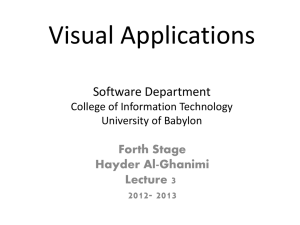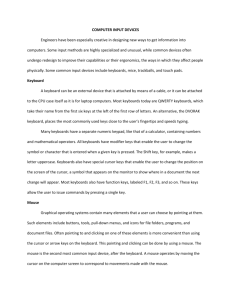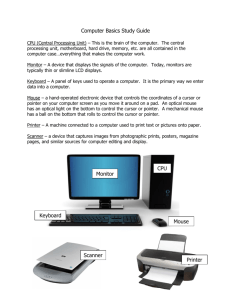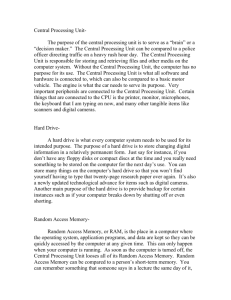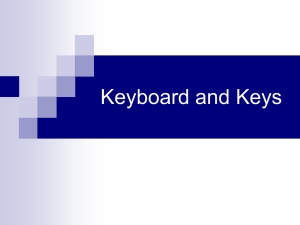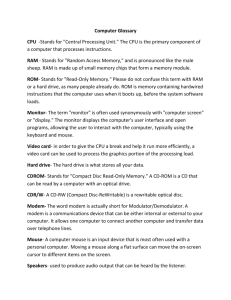Visual Application……………………………………………………. Lecture 2 Part I: The Computer 2012-2013
advertisement
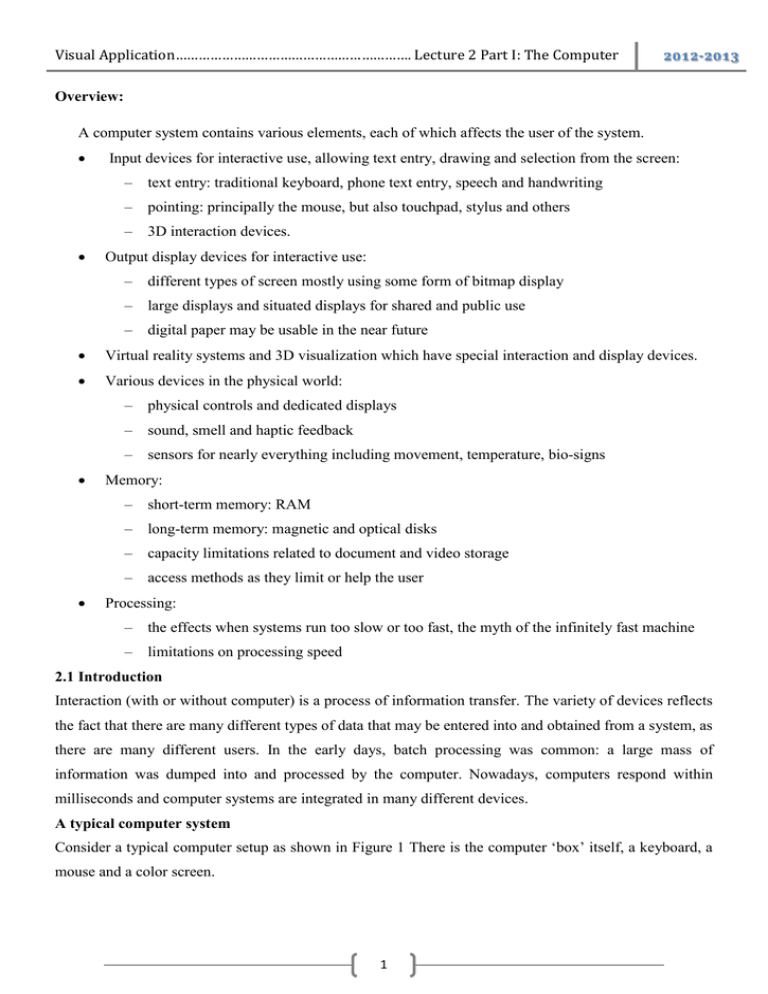
Visual Application……………………………………………………. Lecture 2 Part I: The Computer 2012-2013 Overview: A computer system contains various elements, each of which affects the user of the system. Input devices for interactive use, allowing text entry, drawing and selection from the screen: – text entry: traditional keyboard, phone text entry, speech and handwriting – pointing: principally the mouse, but also touchpad, stylus and others – 3D interaction devices. Output display devices for interactive use: – different types of screen mostly using some form of bitmap display – large displays and situated displays for shared and public use – digital paper may be usable in the near future Virtual reality systems and 3D visualization which have special interaction and display devices. Various devices in the physical world: – physical controls and dedicated displays – sound, smell and haptic feedback – sensors for nearly everything including movement, temperature, bio-signs Memory: – short-term memory: RAM – long-term memory: magnetic and optical disks – capacity limitations related to document and video storage – access methods as they limit or help the user Processing: – the effects when systems run too slow or too fast, the myth of the infinitely fast machine – limitations on processing speed 2.1 Introduction Interaction (with or without computer) is a process of information transfer. The variety of devices reflects the fact that there are many different types of data that may be entered into and obtained from a system, as there are many different users. In the early days, batch processing was common: a large mass of information was dumped into and processed by the computer. Nowadays, computers respond within milliseconds and computer systems are integrated in many different devices. A typical computer system Consider a typical computer setup as shown in Figure 1 There is the computer „box‟ itself, a keyboard, a mouse and a color screen. 1 Visual Application……………………………………………………. Lecture 2 Part I: The Computer 2012-2013 Figure 1: Typical Computer System 2.2 Text entry devices 2.2.1 The alphanumeric keyboard The vast majority of keyboards have a standardized layout, known by the first six letters on the top row: QWERTY. The non-alphanumeric keys are not standardized. This layout is not optimal for typing, but dates from the time of mechanical limitations of the typewriter. Today, the keys can also be arranged in alphabetic order (the alphabetic keyboard), but this does not improve typing performance. The DVORAK keyboard does, placing the keys in a different order on a similar layout as found on the QWERTY keyboards. The layout minimized the stretch of fingers and the use of weak fingers, reducing fatigue and increasing typing speed (10-15%). Figure 2: The Standard QWERTY keyboard 2.2.2 Chord keyboards Is a computer input device that allows the user to enter characters or commands formed by pressing several keys together, like playing a "chord" on a piano. The large number of combinations available from a small number of keys allows text or commands to be entered with one hand, leaving the other hand free. On chord keyboards, only a few keys are used. Letters are produces pressing multiple keys at once. They are smaller than conventional keyboards and have a short learning time. 2.2.3 Phone pad and T9 entry The numeric keys on a cellphone can be pressed more than once to enter letters. Most phones have 2 keypad modes: a numeric and an alphabetic mode. Most phones have additional modes for entering (initial) capitals. On modern phones you can also find the T9-algorithm (The acronym T9 stands for Text on 9 keys. T9 predictive texting makes SMS messaging faster especially for non-QWERTY cell phones without full keyboards. Instead of tapping the “4” key three times to input the letter “i” in a text message, 2 Visual Application……………………………………………………. Lecture 2 Part I: The Computer 2012-2013 with T9 you can just tap “4663” to spell the word “good”. With T9 active, you‟d only have to tap each number once per letter. Most modern cell phones have T9 included and activated by default.). This uses a large dictionary to disambiguate words by typing the relevant letters keys once. 2.2.4 Handwriting recognition Current technology is still fairly inaccurate and makes a lot of mistakes, partly due to the enormous differences between people‟s handwriting. HR deals mostly worth stroke information: the way in which the letter is drawn, not the letter itself. Therefore, online recognition is most accurate. HR has the advantage of size and accuracy over small keyboards and are therefore often used in mobile computing. 2.2.5 Speech recognition The performance of speech recognition is still relatively low, even for a restricted vocabulary. Adjusting the system for use with natural language gives birth to even more problems: the „errors‟ in natural language use, different voices, emotions and accents etc. This means the system has to be tuned for each different user. SR can be used in 3 scenarios: as an alternative text entry device, replacing the keyboard in the current software, with new software especially designed for SR and in situations where the use of keyboards is impractical or impossible. 2.3 Positioning, pointing and drawing 2.3.1 The mouse The mouse is an indirect input device, because a transformation is required to map from the horizontal nature of the desktop to the vertical alignment of the screen. Invented in 1964 by Engelbart, his mouse used 2 wheels that slid across the desktop and transmitted x; y-coordinates to the computer. There have been experiments with foot-controlled mice. 2.3.2 Touchpad Touchpads are touch-sensitive tablets, operated by sliding the finger over it and are mostly used in notebook computers. Performance can be increased using accelerators. 2.3.3 Trackball and thumbwheel A trackball is an upside-down mouse: instead of moving the device itself, the ball is rolled to move the cursor. Trackballs are often used by RSI users. Thumb-wheels (in 2 dimensions) offer less usability because they can only manipulate the horizontal and vertical movement of the cursor. 1-dimensional thumbwheels are often included on the normal mice to enhance the scrolling. 2.3.4 Joystick and keyboard nipple There are two types of joysticks: absolute sticks, in which the position of the cursor corresponds to the position of the joystick in its base, and isometric sticks, in which the pressure on the stick (in a certain direction) controls the velocity of the cursor in that direction. Keyboard nipples are tiny joysticks that are sometimes used on notebook computers. 2.3.5 Touch-sensitive screens (touchscreens) 3 Visual Application……………………………………………………. Lecture 2 Part I: The Computer 2012-2013 Touchscreens detect the position of the user‟s finger or stylus on the screen itself and are therefore very direct. They work by having the finger/stylus interrupting a matrix of light beams, making capacitance changes on a grid overlaying the screen or by ultrasonic reflections. It is a direct device: no mapping is required. 2.3.6 Stylus and lightpen For more accurate positioning, systems with touch-sensitive surfaces often imply a stylus. An older technology for the same purpose is the lightpen, which emits radiation detected by the screen. A difficulty of this and other direct devices is that pointing obscures the display, making it more di¢ cult to use in rapid successions. 2.3.7 Digitizing tablet A device used for freehand drawing. A resistive tablet detects point contact between two separated conducting sheets. Magnetic, capacitive and electrostatic tablets use special pens. The sonic tablet requires no pad: an ultrasonic sound emitted by the pen is detected by 2 microphones. 2.3.8 Eyegaze Eyegaze allows you to control the computer by looking at it, while wearing special glasses, head-mounted boxes etc. By tracking a laser beam‟s reflection in the eye, the direction in which the eye is looking is determined. The system needs to be tuned and is very expensive, but also very accurate. 2.4 Display devices 2.4.1 Bitmap displays, resolution and color A bitmap-base means that the display is made of a fixed number of dots or pixels in a rectangular grid. The color or intensity at each pixel is held by the computer‟s video card. The more bits per pixel, the more colors/intensities are possible. Also is the resolution of the screen: the total number of pixels (in a 4:3-ratio) and the density of the pixels. Antialiasing: softening the edges of line segments, blurring the discontinuity and making the juggles less obvious. 2.4.2 Technologies In a CRT-monitor a stream of electrons is emitted from an electron gun, which is than focused and directed by magnetic fields. As the beam hits the phosphor-coated screen, the phosphor is excited by the electrons and glows. Flicker can be reduced by increasing the scanning rate or by interlacing, in which odd lines are scanned first, followed by even lines. In LCD‟s a thin layer of liquid crystals is sandwiched between two glass plates. External light passes through the top plate and is polarized. This passes through the crystal and is reflected back to the user‟s eye by the bottom plate. The polarization of each single crystal can be turned electronically. 2.4.3 Digital paper Thin flexible material that can be written to electronically, but keeps it‟s contents when removed from the power supply. 4 Visual Application……………………………………………………. Lecture 2 Part I: The Computer 2012-2013 2.5 Devices for virtual reality and 3D interaction 2.5.1 Positioning in 3D Changing from 2D to VR does not mean going to 3 degrees of freedom, but (sometimes) to 6, because except for moving in 3 dimensions, you can also roll, turn, twist etc. Humans can use a 3D-environment with a 2D-device (mouse). The human mind is therefore capable of handling multiple degrees of indirection. A 3D-input device is the 3D-mouse, which has 6 degrees of freedom: 3 for position (x,y,z), 1 for pitch, yawn and roll. However, sometimes its better to use a data glove: a lycra glove with fibers laid around the fingers, detecting the joint angles of the fingers and thumb. The position of the head can be tracked using a VR-helmed, which can also display the 3D-world to each eye. With other devices, e.g. special clothing or a modified trampoline, the position and movement of the whole body can be tracked. 2.5.2 3D displays 3D can be displayed on normal screens using shadows, depth etc. It is also possible to generate the natural stereoscopic images for both eye positions and have them delivered to the eyes using a VR-helmed. Finally, users can enter a VR cave, where the VR world is projected around them. If the VR-system performances too slow, and there is a delay between movement and image, disorientation and sickness may occur. 2.6 Physical controls, sensors and special devices 2.6.1 Special displays Except for CRT and LCD, there are numerous other display devices, e.g. LED‟s, ganges, dials and headup displays. 2.6.2 Sound output We do not yet know how to utilize sound in a sensible way to achieve maximum effects and information transference in HCI. However, by having sounds confirm a right action, we can speed up interaction. 2.6.3 Touch, feel and smell Force feedback gives different amounts of resistance to an input device depending on the state of the virtual operation. Haptic devices are various forms of force, resistance and texture influencing our physical senses. 2.6.4 Physical controls Not only the function of controls, but also the physical design is important and needs to suit the situation in which it is used: kitchen equipment, for example, needs controls that can be cleaned easily. 2.6.5 Environment and bio-sensing There are many sensors in our environment monitoring our behavior. Their measurements range from temperature and movement to the user‟s emotional state. 5 Visual Application……………………………………………………. Lecture 2 Part I: The Computer 2012-2013 2.7 Memory 2.7.1 RAM and short-term memory (STM) Most current active information is held in the random access memory (RAM). RAM is volatile: contents are lost when the power is turned off. However, there are more expensive or low-power consuming memory techniques that can hold their contents when the power is o¤. 2.7.2 Disks and long-term memory (LTM) There are 2 main techniques used in disks: magnetic disks (floppy, hard-disk, tape) and optical disks. (CD-ROM/ DVD). In comparison to RAM, the computers LTM is rather slow. 2.7.3 Understanding speed and capacity The capacity of RAM is limited and therefore multitask-systems tend to swap background-running programs from RAM to the hard-disk. When the program is fully activated it has to be swapped back, which can cause delays (von Neumann bottleneck). 2.7.4 Compression Compressions techniques can be used to reduce the amount of storage required for text, bitmaps and video. In text, logical contractions in the sentence can be replaced by a short code. In video, differences between frames can be recorded instead of the whole frames. If fractal compression is used, the quality can even improve in the process. 2.7.5 Methods of access Standard database access is by special key fields with an associated index. The user has to know the key before the system can find the information. Indices on databases are limited due to the storage costs, privacy and security. The user‟s mistakes in searching can be compensated by using forgiving systems, for example by matching a key to a database index which corresponds closely. 2.8 Processing and networks 2.8.1 Effects of finite processor speed The processing speed of an interactive system can affect the user by being too slow (which can be avoided by using buffers) or too fast. The faults can be functional, in which the program does the wrong action. Slow responses from the system can also cause the so called cursor tracking and icon wars. If the system is too fast, the user will not have enough time to interpret the system‟s output. 2.8.2 Limitations on interactive performance Several factors that can limit the speed of an interactive system. They can be: _ Computation bound: Make sure the user has an indication of the system‟s progress. _ Storage channel bound: Select the best fitting kind of memory and access technique. _ Graphics bound: The actual time of graphic operations can differ much from the estimates. _ Network capacity 6
